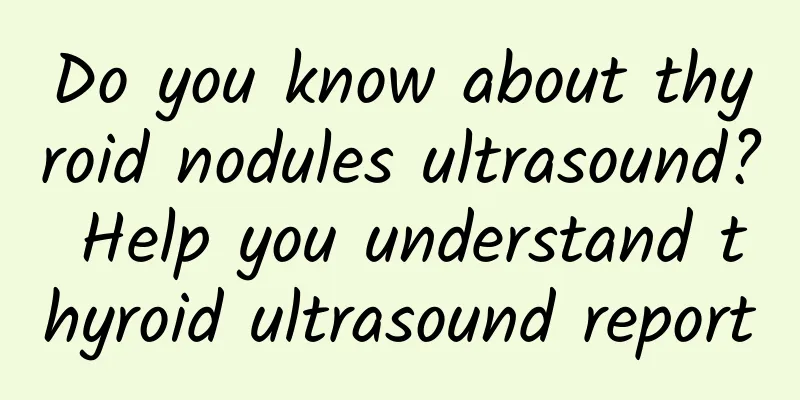How to stabilize high blood pressure in autumn and winter? Follow two principles

|
Editor's note: With the improvement of living standards, health has become the topic we are most concerned about. What is healthy food? How to prevent physical diseases in life? These have become the focus of everyone's attention. People's Health Network has launched the "Jintai Health Garden" column to take stock of the most healthy lifestyle for you and take you into the health garden. Two principles for stabilizing hypertension in autumn and winter Principle 1: Prevention before illness occurs, prevention of progression after illness occurs, and prevention of aging after aging. Prevention before illness occurs means prevention before hypertension occurs; prevention of progression after illness means prevention of further lesions of the heart, brain, kidney, and arteriosclerosis after hypertension occurs. However, if the patient has already developed lesions of the heart, brain, and kidney, aging should be prevented immediately to prevent organ function decline, such as kidney failure, heart failure, etc. Principle 2: Comprehensive prevention and treatment. Comprehensive prevention and treatment includes non-drug treatment and drug treatment. Non-drug treatment means "calmness, tranquility, relaxation, movement, and sleep". Light: The diet must be light. Controlling salt intake is one of the most important tasks in preventing and treating hypertension, and is more important than taking any medicine. Calm: Keep calm. Hypertensive patients are often impatient or work in high-risk positions, such as firefighters and criminal police. Apart from work, you must keep calm after returning to normal life, which helps prevent and treat hypertension. Relaxation: Relax your emotions. Relax from the heart, not just on the surface. Exercise: Exercise is necessary, and the way varies from person to person. If you are old and overweight, climbing mountains can easily damage your knee joints and it is difficult to lower your blood pressure. The best way is to walk briskly on flat ground. Generally speaking, men maintain 10 minutes/km and women maintain 12-13 minutes/km. In this way, walking 3-5 km every day is equivalent to walking briskly for 30-50 minutes. Clinical statistics show that brisk walking every day can reduce blood pressure by at least 8 mmHg. Through exercise, many patients not only have their blood pressure lowered, but also lost weight, improved their physical fitness, and improved their sleep. Sleep: Many hypertensive patients have bad habits before they get sick, such as long-term smoking, drinking, staying up late, etc., especially staying up late can easily cause endocrine disorders, which is a very important reason for high blood pressure. It is recommended that hypertensive patients must go to bed at least before 11 pm every day, because 11 pm to 1 am is the "yin of yin" in the day, especially in winter, which is the yin of cold, often the most harmful to the body. If you are over 35, you should measure your blood pressure when you first see a doctor. How to correctly “measure blood pressure regularly”? First, adults aged 18 and above: monitor your blood pressure regularly, measure your blood pressure at least once a year, and pay attention to changes in blood pressure. Secondly, for seven groups of people, "regularly" means "often": people at high risk of hypertension, such as those who are overweight or obese, have a high-salt diet, smoke, drink alcohol for a long time, are under long-term mental stress, and lack physical activity, as well as those with high-normal blood pressure (120-139/80-89mmHg), who need to measure their blood pressure regularly. Third, over 35 years old: medical institutions measure blood pressure for first-time patients over 35 years old. Fourth, patients with hypertension should conduct self-blood pressure measurement and self-management at home. Those whose blood pressure is up to standard and stable should measure their blood pressure once a week. Those whose blood pressure is not up to standard or is unstable should increase the frequency of self-measurement of blood pressure. Special reminder: When measuring blood pressure, it is recommended to use an upper arm fully automatic electronic blood pressure monitor that has passed international standard certification. How is hypertension diagnosed? In the absence of antihypertensive drugs, if the systolic blood pressure is ≥140 mmHg and/or the diastolic blood pressure is ≥90 mmHg when measured three times on different days, hypertension can be diagnosed. For regular home blood pressure measurement, it is recommended to use an upper arm fully automatic electronic blood pressure monitor. The judgment criteria for home blood pressure measurement values are different from those for clinic blood pressure. Home blood pressure readings ≥135/85 mmHg are considered hypertension. How to effectively prevent hypertension in daily life? 1. Keep exercising: Regular physical activity can prevent and control high blood pressure, such as brisk walking, swimming, Tai Chi, housework, etc. The amount of activity should generally reach moderate intensity. 2. Limit salt intake: A high-salt diet significantly increases the risk of hypertension. Adults should not consume more than 5 grams of salt per day. 3. Reduce the intake of foods rich in fat and sugar, limit the use of cooking oil, and eat more vegetables and fruits. 4. Eat less fast food: Try to eat at home to help control the intake of fat, salt and sugar. 5. Quit smoking: Smoking is harmful to health, smokers should quit smoking as soon as possible. What are the “Patient Instructions” for treatment? 1. The vast majority of patients need to take antihypertensive drugs long-term and regularly, and antihypertensive treatment must meet the standards. 2. Blood pressure target for antihypertensive treatment: For general hypertensive patients, blood pressure should be reduced to below 140/90 mmHg; for patients with diabetes or chronic kidney disease, blood pressure should be reduced to below 130/80 mmHg; for patients over 80 years old, blood pressure should be reduced to below 150/90 mmHg. Patients with coronary heart disease whose diastolic blood pressure is as low as 60 mmHg should be cautious in lowering blood pressure. 3. Most cases of hypertension are primary hypertension, which is generally incurable and requires long-term medication. Do not blindly believe in illegal advertisements or pseudo-scientific propaganda, and do not use health products, health physiotherapy or diet therapy to replace antihypertensive drugs. 4. Most cases of hypertension can be controlled, and those who are not well controlled should seek medical attention promptly. Attention! Hypertension in the elderly is a little special Large pressure difference. Hypertension in the elderly is mainly characterized by increased systolic blood pressure, and the pressure difference is relatively large. This is because their organs undergo degenerative changes, especially the cardiovascular system, with obvious arteriosclerosis, which has almost become an inelastic pipe. When the heart ejects blood, the aorta cannot fully expand, and the sudden increase in blood volume in the artery cannot be buffered, resulting in increased systolic blood pressure, while diastolic blood pressure is relatively low, and the pulse pressure difference increases. Large fluctuations. Elderly hypertension fluctuates greatly, with highs and lows throughout the day, especially systolic blood pressure. This is mainly due to the decreased sensitivity of vascular pressure receptors in elderly patients. Therefore, during antihypertensive drug treatment, blood pressure cannot be measured by one measurement result to determine whether it is normal. It should be measured at least twice a day, and at any time when you feel uncomfortable, and the medication should be adjusted under the guidance of a doctor. It may be false. The elderly are prone to pseudohypertension due to arteriosclerosis. Such patients have poor tolerance to antihypertensive drugs and are more likely to develop serious adverse reactions and complications, so they should be carefully identified. The incidence of pseudohypertension is not high, but it tends to increase with age. Therefore, for patients with very hard peripheral arteries and high blood pressure, but who cannot tolerate antihypertensive treatment and develop serious complications when taking antihypertensive drugs, pseudohypertension should be considered if no obvious signs of damage to important organs such as the brain, heart, and kidneys are found. Postural hypotension is common. Elderly hypertension is easily affected by changes in body position, and the incidence of postural hypotension is high, especially during antihypertensive drug treatment. When the body position changes from lying to sitting, or from squatting to standing, the blood pressure will suddenly drop, and dizziness and fainting will occur. This is also related to the decreased sensitivity of pressure receptors. Therefore, drugs that can cause postural hypotension, such as prazosin and terazosin, should be used with caution. If it must be used, it can be taken once before going to bed at night. If there is no obvious reaction, it can be taken during the day, and it should start with a small dose. Many complications and comorbidities. Due to the decline of physiological functions, the elderly are prone to complications of the heart, brain, and kidneys after suffering from hypertension, such as angina pectoris, myocardial infarction, stroke, renal insufficiency, etc. At this time, special attention should be paid to not use drugs that aggravate the comorbidities. Depression is easy to occur when taking medication. The nervous system function of the elderly is lower, and depression is more likely to occur during medication. Therefore, antihypertensive drugs that act on the central nervous system, such as clonidine and methyldopa, should be avoided. For patients with a tendency to depression, fat-soluble beta-blockers, such as Betaloc, should also be used with caution. If blood pressure is not well controlled, organs will sound the alarm In many cases, the impact of high blood pressure on the human body is like "boiling a frog in warm water". The patient may not feel uncomfortable for a period of time at the beginning, but the body is in a "high pressure" state for a long time, which will slowly cause damage to the organs. Palpitations and chest tightness, the heart is "complaining". If a patient with hypertension has symptoms such as palpitations, chest tightness, chest pain, and lower limb edema, it means that there is something wrong with the heart. Long-term high blood pressure will cause heart enlargement and disorder of cardiac electrical activity, gradually causing decreased cardiac diastolic and systolic function. At this time, the patient will experience palpitations and arrhythmias, and may also experience symptoms such as chest tightness and chest pain after activities due to coronary atherosclerosis and stenosis. Therefore, if a patient with hypertension has the above symptoms, he should go to the hospital as soon as possible for electrocardiogram, cardiac color ultrasound and other examinations, and if necessary, coronary angiography to determine whether there is vascular stenosis or blockage to avoid serious consequences. Swollen eyelids, frequent urination at night, kidneys are "calling for help". If patients with hypertension find swollen eyelids, frequent urination at night, or hematuria, foamy urine, it means that there is something wrong with kidney function. The kidney is the "purifier" of our body, and its function decline is related to long-term hypertension leading to glomerular arteriosclerosis and decreased kidney filtration function. At this time, in addition to further controlling blood pressure, you should go to the hospital for a routine urine test in time to find out whether there is urinary protein, and also do a kidney color Doppler ultrasound to see if there is any abnormality in the kidney structure. The pressure difference between the two arms is large, and the arteries are "complaining". The blood pressure of each person's upper limbs is slightly different. The difference can reach 5 to 10 mmHg for healthy people. However, if a hypertensive patient has a large difference in blood pressure between the two arms, or has lower limb pain after walking for a long time, and it gets better after resting, it means that the upper or lower limb arteries have hardened, or even narrowed or occluded. This is related to the long-term poor control of hypertension and the combination of peripheral arteriosclerosis. At this time, the patient should go to the hospital as soon as possible for vascular ultrasound, enhanced CT, and angiography to identify the blockage site and take relevant treatment as soon as possible. Dizziness and numbness are caused by the "struggle" of the cerebral blood vessels. If a hypertensive patient suddenly experiences dizziness, blurred vision, motor impairment or numbness of the upper and lower limbs, slurred speech, etc., it means that there is a problem with the blood supply to the brain, which affects brain function and causes a stroke. This is caused by long-term high blood pressure, which causes blockage or rupture of cerebral blood vessels. Family members should call 120 immediately to facilitate doctors to perform a CT scan of the patient's head as soon as possible and prepare for thrombolytic therapy or interventional thrombectomy. Poorly controlled high blood pressure can harm the eye fundus Eyes are not only windows to the soul, but also reflect the condition of patients with hypertension. By observing the fundus, the stage, type and prognosis of hypertension can be determined. If patients do not pay attention, hypertension will slowly damage the fundus through four steps. Step 1: Stimulate the arterioles to become thinner. Long-term and continuous increase in blood pressure can cause some pathological changes in the retina. Under repeated high-pressure stimulation, the retinal arterioles will be slightly narrowed and slightly hardened in the early stage. The patient may experience vision loss, dark shadows in front of the eyes, etc., but there are no other abnormalities. If the patient discovers and pays attention to it in time, and controls blood pressure through drug treatment, the retinal blood vessels can gradually return to normal and no permanent changes will occur. Step 2: Continuous hardening and narrowing of small arteries. If blood pressure rises for a long time and develops to a certain stage, the retina will further change, the arteries will continue to narrow, the retinal arteriosclerosis will be obvious, the arteries will show "silver line reaction", the arterial diameter will narrow unevenly, and there will be cross pressure marks between arteries and veins. Step 3: Bleeding, exudation and edema. As the disease progresses, blood pressure rises sharply, and retinal edema, bleeding and exudation may occur. This situation is hypertensive arteriosclerotic retinopathy. Step 4: Severe visual impairment. If accompanied by optic disc edema and heavy bleeding, the exudate will enter the vitreous or deposit in the macula, and radial waxy yellow spots will appear on the fundus. At this time, it may cause visual impairment in patients, such as blurred vision, deformation or shrinkage. How to measure blood pressure correctly Normal people's blood pressure fluctuates throughout the day. It is lowest when sleeping and remains stable when sitting quietly. Stress, smoking, talking and drinking coffee will increase blood pressure, while blood pressure will decrease after meals, exercise and reading quietly. Therefore, to accurately measure blood pressure, you should not take medicine or eat one hour before measuring blood pressure. You should not smoke, drink coffee or tea within 30 minutes before measuring. You should urinate in advance to avoid holding urine. A full bladder will increase blood pressure. Before measuring blood pressure, you should sit quietly in a room with moderate temperature for 5 minutes. In a quiet state, measure the same upper limb at the same time, so that it is more accurate to adjust the medication. Regardless of gender or whether or not a person has hypertension, blood pressure is generally measured on the right upper arm, because the blood pressure standard is also formulated based on the results of blood pressure on the right upper arm, and most measurements are taken on the right upper arm. When measuring, relax your palms naturally with your hands facing up, place the bottom of the blood pressure monitor wrist strap on a storage box or cushion, and position the wrist strap at the same height as the heart, not too high or too low. If the right side has suffered from vascular malformations, large arteritis, hemiplegia, or the left side has a higher measured value than the right side, it is recommended to measure the left side, and use the measurement on the higher side as the measurement result. People who are measuring their blood pressure for the first time can choose to measure the blood pressure on both the left and right upper arms to obtain accurate blood pressure. Once it is relatively clear which arm has high blood pressure, only measure the blood pressure on the higher side of the upper arm. Should I measure my blood pressure while sitting or lying down? Should you sit or lie down when measuring blood pressure in the morning? This question is very important because different postures will affect the blood pressure measurement results. It is recommended that elderly people with limited mobility measure their blood pressure both in the supine and sitting positions. If there is little difference, the sitting position measurement should prevail. When sitting, the brachial artery is closer to the heart level, and the blood pressure is relatively more accurate. Some patients with hypertension have no symptoms and never know that they have high blood pressure until complications occur and they go to the hospital. Hypertension poses a long-term threat to target organs such as blood vessels, kidneys, and heart. It is a disease that requires long-term management and regular monitoring. It is recommended to choose long-acting antihypertensive drugs to moderate and stabilize blood pressure. For daily blood pressure management, you need to have a "monitoring note", including blood pressure in the morning before meals, after three meals, and before bedtime. Bring the monitoring data to the doctor and adjust the use and dosage of antihypertensive drugs accordingly to achieve precise treatment. Many cardiovascular and cerebrovascular events occur in the early morning. Controlling the morning blood pressure can reduce the occurrence of malignant cardiovascular and cerebrovascular diseases. (People's Health Network compiled from Life Times, Guangzhou Daily, and China Journal of Traditional Chinese Medicine) |
<<: Winter always has cold hands and feet. Here are some warm recipes to keep you warm in winter.
Recommend
Will cervical erosion surgery affect pregnancy?
Cervical erosion is very common in life, and many...
Delayed menstruation, nausea, abdominal pain
Delayed menstruation and lower abdominal pain are...
The pros and cons of sleeping naked in summer for women
Summer is not like winter when we wear thick clot...
Can I take a hot spring bath after the confinement period?
Confinement is a very important period of time in...
What are the hazards of pregnancy complicated with Chlamydia trachomatis infection?
Pregnancy diseases and Chlamydia trachomatis infe...
How long after the ring is removed
The IUD, also known as the intrauterine contracep...
What is the fastest way for women to treat frequent urination?
Frequent urination often completely disrupts a pe...
What is the method of calculating menstrual period?
Women are different from men, especially in terms...
I still have lochia after a full month of cesarean section
After giving birth, some residual substances will...
Breast 4a benign or malignant
Breast 4A is a malignant tumor. The probability o...
How to prevent tick bites? What are the symptoms of tick bites?
What exactly are ticks? What harm do ticks do to ...
Breast pain in 5 months of pregnancy
It is normal to have chest pain during the fifth ...
Brown blood picture at the beginning of menstruation
Menstruation is the regular vaginal bleeding that...
Fallopian tube cyst
The fallopian tubes of women are very important o...









